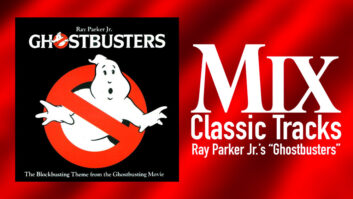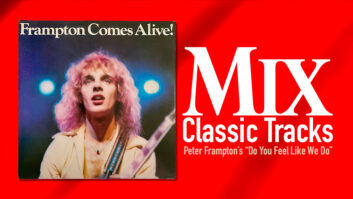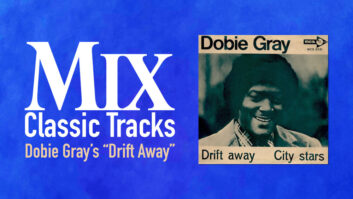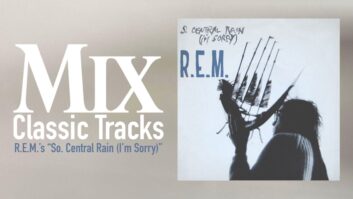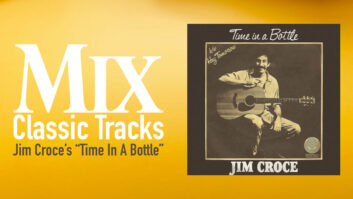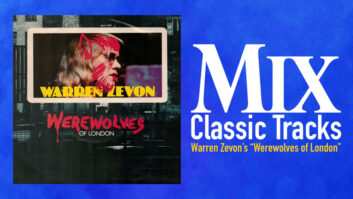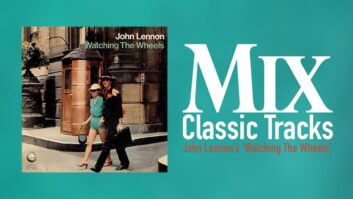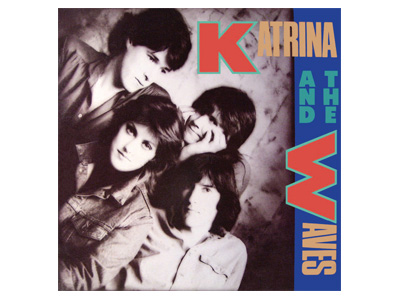
A song is in select company when listeners know it from the drum intro. Hits such as “Superstition,” “Get Off of My Cloud” and “Wipeout” come to mind. In 1985 this month’s Classic Track, “Walking on Sunshine,” that smile set to music, joined those ranks.
The band Katrina and the Waves evolved from an English group called The Waves, which included guitarist/songwriter Kimberley Rew and drummer Alex Cooper. The Waves were together for a couple of years in the 1970s and then disbanded when Rew left to join Robyn Hitchcock’s band the Soft Boys in 1978. Meanwhile, Cooper joined a cover band called Mama’s Cookin’, which featured American-born singer Katrina Leskanich. When the Soft Boys called it a day in 1981, Cooper reconnected with Rew, and a band comprising Rew, Cooper, Leskanich, singer/guitarist Vince de la Cruz and bassist Bob Jakins reclaimed the name The Waves. (Note: Jakins left The Waves soon after and de la Cruz became the bass player.)
In the new Waves lineup, Rew would put his writing talent to work on original tunes for Leskanich to sing. When sessions began for the group’s first LP, they changed their name to Katrina and the Waves. The songs on the album were written by Rew and recorded on the band’s own dime, with engineer/producer/musician Pat Collier. That first album, Walking on Sunshine, included the first recorded version of the song.
“Until about 1980, I’d been playing in bands. I played in a punk band called The Vibrators and then I had my own band called The Boyfriends, and that finished around ’80,” Collier says. “I had a small studio in a rehearsal room, which started as a 4-track room, but then it went to 8-track and then 24-track. I was recording indie records, and that’s how I met Kimberley when he was in the Soft Boys. That rehearsal studio was called Alaska; it was in a railway arch under Waterloo Station [London], so it was incredibly noisy and damp and very horrible.
“Alaska Studios is still there to this day,” Collier continues. “That had a Soundcraft 1624 desk and a Soundcraft multitrack machine—very limited gear, very limited mics, very limited everything. We also worked in my other studio, which was much more spacious, in a more sensible building.
That was Greenhouse Studios, and it also had a 1624 desk as well as a 3M M79 machine and a little more gear, but not much: dbx 160s, a couple of Neumann U87 microphones, but it was mainly Shure 57s. “The majority of what we did was in Greenhouse. They would always record as an entire band. They might patch and repair stuff after. They would always do the vocal again. But the basic thing was live.”
Collier recalls that on all of the sessions he had with KATW, “Guitars would have been one 57 bang in the middle of the speaker.” On drums, he used 57s on snare and toms, though overheads may have been AKG C414s. On kick, he put up an AKG D12. “There were no room mics on that session,” Collier says.
Everything went through the mic preamps in the Soundcraft board. Leskanich overdubbed her lead vocal into a U87, which went through a dbx 160 compressor. “I’d always get Katrina to run it through, [then I’d] set the level, set the compression and say, ‘Let’s get the take,’ at which time the volume would double, the compressor would go off-scale, and the tape machine would go into the red. Basically Katrina did one-take vocals that were amazing, and I’d say, ‘It’s too loud,’ and the band would say, ‘It sounds great!’ It was way hotter than I would have liked, but there you go.”
On “Walking on Sunshine,” horn parts were also overdubbed, in addition to the “organ” played by Nick Glennie-Smith in Alaska Studios. “That sounds like a Hammond, but I think it was just a sampling keyboard—probably an Emulator,” Collier says.
The album was picked up by a small Canadian label Attic Records and got most of its play in Canada. Attic Records and Collier also helped them make a second album, Katrina and the Waves, and after that second album released, things really began to look up: Capitol Records signed the band with the idea of releasing a selection of songs from both records, as a new album that would be widely promoted.
However, Capitol wanted some of the songs—particularly “Walking Down to Liverpool” and “Walking on Sunshine”—to be “tarted up,” as Collier says, to make them more single-worthy. And the bandmembers were dissatisfied with the drums on “Walking on Sunshine.” “So, we did loads of versions; we just kept going round and round in circles. We kept redoing it nonstop,” Collier says.
Ultimately, the label decided to outsource a remix. The tracks were handed off to engineer/producer Scott Litt at the Power Station in New York City.
At that time, Litt worked freelance, but he had served on the Power Station engineering staff from 1978 through 1983. Just weeks after starting his New York engineering career at Herb Abramson’s A-1 Sound Studios, Litt had taken a walk over to the Power Station with his resume in his hand. He was greeted by a receptionist and studio co-founder Bob Walters, who just happened to be in the lobby.
“Bob said, ‘We don’t take resumes,’” Litt recalls. “But he looked me up and down and asked me a few questions, and then to my amazement, he said, ‘Come back tomorrow and we’ll let you sit in on a session. Just keep your mouth shut.’”
The next day, Litt visited Power Station’s Studio B, where Nile Rodgers and Bernard Edwards of Chic were producing Sister Sledge’s track “He’s the Greatest Dancer,” with engineer Bob Clearmountain manning the Neve 8068 board. The sound of that production coming through the studio’s Altec Big Red mains blew Litt’s mind, but he kept his mouth shut, and that earned him a job as an assistant.
It was only weeks before Litt jumped from assistant to engineer at Power Station, after being asked to fill in when another engineer got sick in the middle of tracking a Herbie Mann album. Litt built a reputation as a reliable and innovative engineer and then as a producer. He went freelance, but he still worked on plenty of projects at Power Station.
“Remixing tracks was a newer way of working then,” Litt recalls. “The usual way was for one person to do everything from recording through mixing. One of the first jobs where I was hired to remix was Katrina and the Waves’ first album for Capitol. The band had come from London to the U.S. to meet with the record company, maybe finalize artwork, but also to be in New York while I mixed the record. We did it in Studio B, which I had an affinity for since that first day at the studio.”
When Litt first heard first “Sunshine,” he says his overall impression was that the song was mainly finished, but the version he was given had a drum machine that needed to be replaced with real drums. This possibly seems a bit surprising, considering how hard Collier and the band had worked on getting the right drum take.
“Scott is probably correct to say that drum machine sounds were used in the drum recording. At that time, I would routinely trigger bass drum and snare sounds from a Linn Drum 2 to bolster the real drums,” Collier explains. “It is entirely possible that I only printed the Linn Drum sounds for bass drum and snare, as tracks were at a premium.
“The main problem with the drum recording, though, as replaced by Scott, was that Alex, having had one last go at doing the drums in London, had pushed so far ahead of the beat that everything else felt way behind. When [Scott] pointed this out, it seemed glaringly obvious, but somehow the band and myself had managed to overlook this rather major point.”
Regardless of what was on the tape from London, Litt did re-record the drums. He positioned Cooper in the back right corner of the studio. The kit was miked up with Sennheiser 421s on the bass drum and tom toms, an AKG 451 on hi-hat, and Shure SM57s on snare top and bottom. “I’d put the bottom one out of phase with the top because they’re seeing the sound source from 180 degrees different angles,” Litt says. “That was a great technique that Clearmountain used, not only on snare but on tom toms—miking underneath the tom and putting that out of phase with the top to get a deeper, more reverberant sound.
“And when we were working in a smaller room like that, room mics became not that big a deal,” Litt says. “If there were room mics, they would probably be Neumann KM84s, only eight or 10 feet from the drums; I would gate that off the snare just to give more life to the snare.
“Alex did [the final drums] in one or two takes, and it was phenomenal,” Litt continues. “All of a sudden the song exploded. As soon as the drums were done, that spurred us on to do more. I was flying guitars around. I put that intro on the beginning of the drums. At the time, one of my favorite songs was ‘Wake Me Up Before You Go Go’ by Wham, and that has a real R&B vibe to it, so that was a bit of an inspiration for me. You can probably hear it when you listen to it.”
As for the sound of the drums themselves, “I’m sure the tricks that I used at the time, the mix ideas [involved] the live chamber; there’s definitely a slapback on that, and I’m sure that would be a tape delay that I used on the drums,” Litt says.
Litt also moved some puzzle pieces around a bit to beef up the impact of the song. He held the horns out of the first chorus, for example, and apparently Leskanich’s “Woo!” was somewhere else in the song, but Litt pushed it up front to before the horns come in.
With his critical distance from the original, Litt seemed to have just the right sense of what the song needed to put it over the top. When the remixed version was released, “Walking on Sunshine” charted all over Europe, Canada and Australia, and it peaked at Number 9 in the U.S. By some accounts, the song has earned millions in licensing royalties for the bandmembers, who share rights to the song.
“It’s great! Absolutely great,” Collier says. “It was a treat for me to go to New York and a treat for me to see The Power Station, and Scott absolutely made that track. He took it in hand and made it what it is.”
Today, Collier is still fighting the good fight in London. “I do a lot of old-fashioned punk. I started in punk bands 40 years ago, and I’m proud to still be doing it,” he says. Collier’s numerous credits also include the Jesus and Mary Chain, Soup Dragons and the last five albums by seminal punks the UK Subs.
And Scott Litt, who has worked with cutting-edge artists such as Patti Smith and Nirvana is now best known for producing several of R.E.M.’s most successful albums, including Grammy winner Out of Time, and Automatic for the People, which Litt was remixing for a 25th-anniversary Dolby Atmos release when we spoke.
Litt is proud of his earlier recordings, but when he remembers the “Sunshine” sessions, he remembers feeling a bit sheepish.
“I remember it was 6 a.m. on a Saturday and I had just put the drum intro in the front, and who walks in but Tony Bongiovi,” Litt recalls. “He had done some early mixing for Motown and he was really entrenched in that R&B tight and classic sound. He heard the song and he loved it. I was excited and a little full of myself and I walked out into the lobby of the Power Station and I ran into another engineer, Jason Corsaro. He said, ‘What are you working on?’ and I said, ‘I just finished mixing this song, do you want to check it out?’ He came into Studio B and listened to it, and he’s like, ‘It sounds good. Do you want to hear what I’m working on?’
“So I go into Studio C where he was working on the band Power Station: Robert Palmer with the guys from Duran Duran. And what Jason played me was the song ‘Some Like It Hot.’ It was the craziest sounding thing ever. The drums sounded like they came from another world, and I thought, ‘I just finished a song that couldn’t sound more ’60s if you tried, and this song sounds like the future.’”
